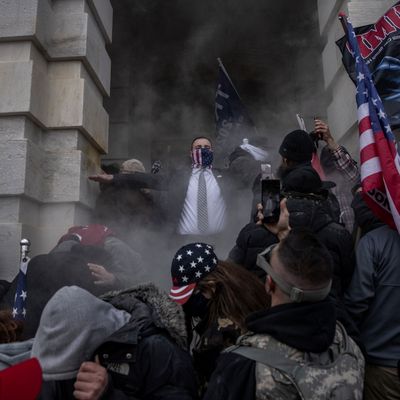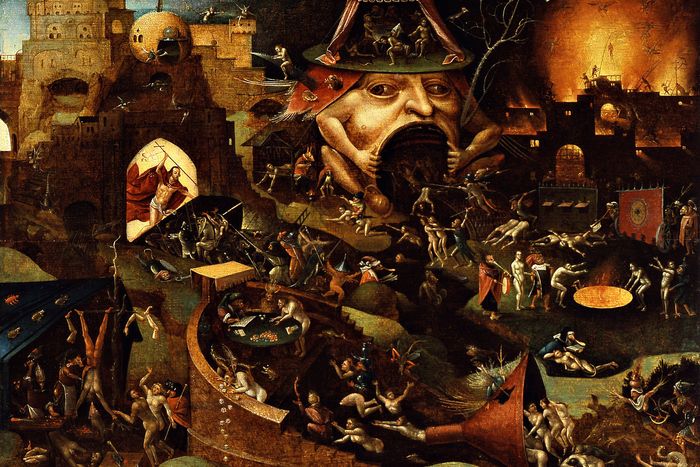
Incredible pictures streamed out of Washington, D.C., on January 6. Staggering, depressing, laughably birdbrained images of self-styled revolutionaries, QAnon crackpots, Wall Street types in baseball caps and flak jackets, paranoids, cultists, grandmas, goons, Oath Keepers, burnouts, paintball guerrillas, conspiracy theorists, retirees, and stay-at-home alt-right dads armed with spears, guns, and tasers. Many of these were photographs taken of the mob by the mob. We saw videos made by news crews and rioters alike. All showed us an ocean of mostly white people in red hats surging up to and inside the U.S. Capitol Building, crashing through windows, beating (or taking selfies with) police, and calling for the deaths of members of the U.S. government.
After Trump finished his speech at his “Save America” rally last week, I turned off the TV. But the danger in the air made me turn it back on. I started scrolling through social media and right-wing sites, and the images flooded in. No one pictured attacking the Capitol appeared to have the slightest fear of repercussions. Some carried “This Is Our 1776” signs. I saw videos of people falling while trying to scale walls; some seemed to spray their own cohorts with mace, while others carrying “Don’t Tread on Me” flags were shoved down by compatriots with the same flag. It was like watching a dog eating its own feces, a clown act, and an actual insurrection all at once. Together, these images are some of the scariest and stupidest I have ever seen.
They’re also unsurprising in the extreme.
As an older person, I recognize in the pictures something that has been here my whole life, something familiar: a look in the mob’s faces that I saw on TV as I watched MLK march not far from my childhood home in the Chicago suburb of Cicero in 1966. Back then, I watched white Americans who looked just like my neighbors screaming, consumed, animalistic, archaic. I turned away from the TV and saw the same look on my stepmother’s face. My stepbrothers said King should be shot. I later saw it firsthand in the summer of 1968, when I took the subway to protests in Chicago’s Grant Park. It was in the faces of the policemen and later in those of Chicago machine politicians. The pictures from the January 6 mob are not pictures of the underdog.
As an art critic, I take a step back to access the deeper contents of these strange images. In the pictures of that day, I see totemism, tribal warfare, incompetence, half-madness, vengeance, white privilege, rage, cruelty. These pictures are what would happen if Facebook became flesh. These are people all speaking at once to everyone else, all claiming that their facts are real and everyone else’s are fake. This gives the pictures a new kind of uncanniness — the group mind doing old things in new languages while sharing a single nervous system. As primary documents, they are intimate. Scrolling through, we storm the Capitol barricades with the red-hatted mob; we surge forward, make our way up and down stairwells, get lost. We hear the laughing, the chants of “Hang Mike Pence,” the members of the mob asking where the bathrooms are. On Parler and Newsmax, I watched invaders watching themselves on their own social-media platforms. The feedback loop was astonishing and insane, the moment transformed into a sort of collective far-right group portrait.
I also notice what we don’t see in them: Trump. He watched the riot unfold the same way the rest of us did, onscreen. These pictures show the crowd finally on its own, acting as one, with no constraints and almost no authority in sight.
What other images have ever looked this way? Fellini gave us crazed carnivals of decadence, ugliness, barbarism, and corpulence. I flash on history paintings of vast armies clashing; on January 6, the crowd donned vivid red, a deluded Trumpist army laying siege to a building, all while carrying flags and banners. Bosch pictured mindless insanity in hell: people endlessly spurting bats from their asses, being stabbed for all eternity, gripped, sickened souls. Here, I see a crowd of political cannibals, feeding on one another’s obsessions.
I am reminded of three earlier photographs that stood in for an entire event or era and changed it: Nick Ut’s 1972 photograph of the naked 9-year-old Phan Thi Kim Phuc, screaming and running after she and her village in Vietnam were napalmed by American bombers; David Jackson’s 1955 image of the battered body of 14-year-old Emmett Till, murdered by white men; and John Filo’s 1970 image of 14-year-old Mary Ann Vecchio, screaming over the body of 20-year-old Jeffrey Miller after he was shot by the Ohio National Guard at Kent State.
The difference in these new pictures, however, is sadly telling. In fact, we are already seeing that exact perversion of the “meaning” of these images in the herculean effort being made by elected Republican representatives and all of right-wing media to twist these pictures into things that they are not: the regretful expression of only a few, an exercise in free speech. The rioters themselves seem to think that they are the burning girl, the murdered boy, the crying woman. These new pictures are unlike those older pictures in another way too: People are already shrugging them off. The older pictures still burn.
The riot at the Capitol wasn’t America’s first rendezvous with destiny in this century: The other, of course, was September 11, 2001. Both events gave us something tragic and unimagined, unfolding in the span of only a few hours and watched in real time around the world. But the images and events of January 6 are, once again, not the same.
The images of the fallen towers were abstract: Death was seen in the absence of bodies, the missing buildings. We saw only smoke, fire, ash, a ruined skyline. This abstraction made it possible for authorities to interpret those photos any way they wanted and then pin the blame elsewhere, starting what has now been nearly 20 years of war. The pictures from September 11 seemed to show annihilation, an invading force from outside — an archaic force slamming into modern politics. In these new pictures, that demonic force is us.


